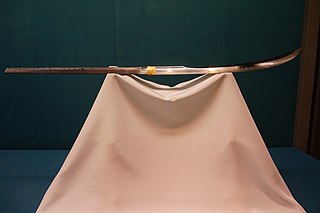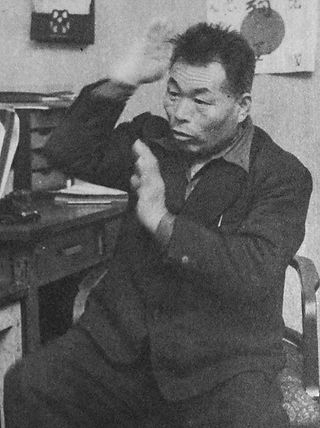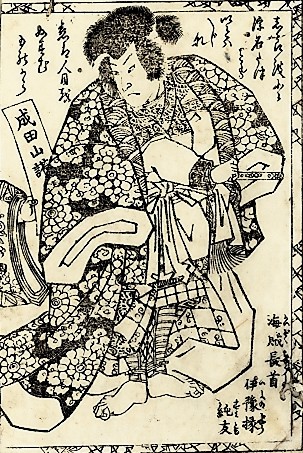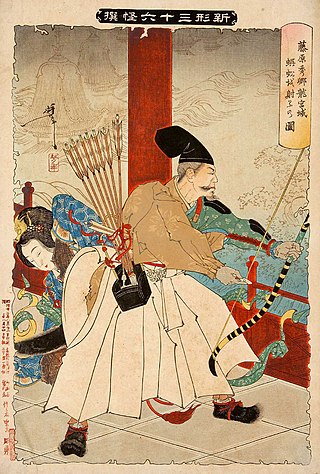Related Research Articles

Shogun, officially Sei-i Taishōgun, was the title of the military dictators of Japan during most of the period spanning from 1185 to 1868. Nominally appointed by the Emperor, shoguns were usually the de facto rulers of the country, although during part of the Kamakura period, shoguns were themselves figureheads, with real power in the hands of the Shikken of the Hōjō clan.

The naginata is a pole weapon and one of several varieties of traditionally made Japanese blades (nihontō). Naginata were originally used by the samurai class of feudal Japan, as well as by ashigaru and sōhei. The naginata is the iconic weapon of the onna-musha, a type of female warrior belonging to the Japanese nobility. A common misconception is that the Naginata is a sword, rather than a polearm.

The Taira (平) was one of the four most important clans that dominated Japanese politics during the Heian, Kamakura and Muromachi periods of Japanese history – the others being the Minamoto, the Fujiwara, and the Tachibana. The clan is divided into four major groups, named after the emperors they descended from: Kanmu Heishi, Ninmyō Heishi, Montoku Heishi, and Kōkō Heishi.

A kusarigama is a traditional Japanese weapon that consists of a kama on a kusari-fundo – a type of metal chain (kusari) with a heavy iron weight (fundo) at the end. The kusarigama is said to have been developed during the Muromachi period. The art of handling the kusarigama is called kusarigamajutsu.

Taira no Masakado was a Heian period provincial magnate (gōzoku) and samurai based in eastern Japan, notable for leading the first recorded uprising against the central government in Kyōto.

Kashima Shin-ryū (鹿島神流) is a Japanese koryū martial art whose foundation dates back to the early 16th century. The art developed some notoriety in Japan during the early 20th century under Kunii Zen'ya (1894-1966), the 18th generation sōke (headmaster). The current sōke is the 21st generation, Kunii Masakatsu. While the line is still headed by the Kunii family, the title of sōke is now largely honorific, and the responsibility for the preservation and transmission of the ryūha now lies in the shihanke line, currently represented by the 19th generation, Seki Humitake.

Fujiwara no Sumitomo was a Japanese Heian era court noble and warrior. From 939 to 941 he aided the Taira clan in a series of revolts.

Minamoto no Mitsunaka was a Japanese samurai and court official of the Heian period. He served as Chinjufu-shōgun and acting governor of Settsu Province. His association with the Fujiwara clan made him one of the wealthiest and most powerful courtiers of his day.

Gashadokuro are mythical creatures in modern Japanese mythology.

Fujiwara no Hidesato was a Japanese aristocrat, courtier and samurai lord of the tenth century in the Heian period. He is famous for his military exploits and courage, and is regarded as the common ancestor of numerous clans, including the Ōshū branch of the Fujiwara clan.
Oyumi were ancient Japanese artillery pieces that first appeared in the seventh century. It is unknown exactly what kind of weapon the Oyumi was or how it looked, as there are no surviving examples or illustrations, but the Oyumi is thought to have been a type of siege crossbow.
Dō is the go-on vocalization of the Japanese kanji道, corresponding to Mandarin Chinese (pinyin) dào, meaning "way", with connotations of "philosophy, doctrine".

The Tengyō no Ran (天慶の乱), or Jōhei Tengyō no Ran refers to the name of a brief medieval Japanese conflict, in which Taira no Masakado rebelled against the central government. He was defeated after 59 days of fighting with the imperial forces led by Fujiwara Hidesato and Taira Sadamori, who was Masakado's kinsman. One of the legends created about the conflict described how Masakado, fearing Hidesato's archery skills, employed doppelganger bodyguards to protect himself. The warrior-rebel was beheaded on 25 March 940 CE during the Battle of Kojima.
Hasetsukabe no Koharumaru was a boy spy of Heian period Japan. He is known from the 10th century military chronicle Shōmonki. Recruited to spy against his lord, the rebel Taira no Masakado, he was ultimately discovered and killed.
Shinbu is a Japanese word, meaning "military might" or, in the narrow sense, "sublime martial moral power". The most common orthography of the word consists of the characters shin/kami (神), meaning "deity" or "something divine", and bu (武), denoting military, chivalry or arms. The idea of shinbu embraces physical, spiritual and ethical issues and denotes the condition when all basic principles of martial art are applied simultaneously and in balance. The phrase shinbu ni shite fusetsu appears in a number of treatises from Tokugawa era, the best known of which is Neko no myōjutsu.
The Bugei jūhappan is a selection of combat techniques and martial arts used by the samurai of Tokugawa-era Japan. Established by Hirayama Gyozo, the concept is based on earlier Chinese traditions, such as Eighteen Arms of Wushu.
Suwariwaza (座り技) is the generic name for techniques performed in the seated stance in traditional Japanese (koryū) martial arts. The word waza means technique. In aikido and judo, suwariwaza techniques are performed by practitioners seated opposite to each other in the seiza position, the formal style of sitting in Japanese culture. In iaido, a single practitioner starts in many cases from suwariwaza, and executes sword techniques from the seated stance, though not necessarily from a static and immobile position.
Matsumoto Bizen-no-kami Masanobu (松本備前守正元) was a semi-legendary Japanese warrior and founder of the Kashima Shin-ryū school of swordsmanship and a member of the noble lineage of the ancient Ki clan.

Zenya Kunii was a Japanese martial artist. He was 18th soke of the Kashima Shin-ryū school. Known as the "Saint of the Sword" and the "Modern Miyamoto Musashi", he was held as one of the greatest traditional martial artists of the 20th century in Japan, as well as one of the most controversial figures in their community.
References
- ↑ "Karl Friday". University of Georgia. Retrieved 11 April 2022.
- ↑ Miliaresis, Grigoris (2021). "Battling the samurai myths: An interview with historian Karl Friday". Budo Japan. Retrieved 11 April 2022.
- ↑ "On Teaching, an interview with Karl Friday". The Journal of Alternative Perspectives on the Martial Arts and Sciences. February 2002. Retrieved 11 April 2022.
- ↑ Piggott, Joan R. (August 2010). "The First Samurai: The Life and Legend of the Warrior Rebel Taira Masakado. By Karl F. Friday. Hoboken, N.J.: Wiley, 2008. xii, 220 pp. $24.95 (cloth)". The Journal of Asian Studies. 69 (3): 904–906. doi: 10.1017/S0021911810001750 .
- ↑ Lamers, Jeroen Pieter (2005). "Samurai, Warfare and the State in Early Medieval Japan (review)". The Journal of Japanese Studies. 31 (2): 466–469. doi:10.1353/jjs.2005.0049. S2CID 145639749.
- ↑ Goff, Janet (July–September 1998). "Legacies of the Sword: The Kashima-Shinryu and Samurai Marital Culture". Japan Quarterly. 45 (3): 105–106. ProQuest 234913538.
- ↑ Reviews of Hired Swords include:
- Steenstrup, Carl (1992). "Reviewed Work: Hired Swords: The Rise of Private Warrior Power in Early Japan. by Karl F. Friday". Monumenta Nipponica. 47 (4): 541–544. doi:10.2307/2385340. JSTOR 2385340.
- Hesselink, Reinier H. (January 1993). "Hired Swords: The Rise of Private Warrior Power in Early Japan by Karl F. Friday (Book Review)". Journal of Military History. 57 (1): 134. doi:10.2307/2944227. JSTOR 2944227. ProQuest 1296648903.
- Havens, Thomas R. H. (1993). "Hired Swords: The Rise of Private Warrior Power in Early Japan Friday, Karl F.: Stanford, CA: Stanford University Press, 265 pp., Publication Date: May 1992". History: Reviews of New Books. 21 (4): 177. doi:10.1080/03612759.1993.9948796.
- Earns, Lane (February 1993). "Hired Sword: The Rise of Private Warrior Power in Early Japan. By Karl F. Friday. Stanford: Stanford University Press, 1992. 265 pp. $32.95". The Journal of Asian Studies. 52 (1): 165–167. doi: 10.2307/2059183 . JSTOR 2059183.